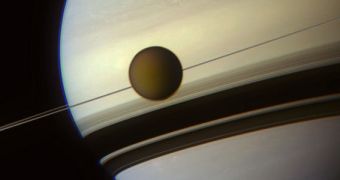Since mission controllers at the NASA Jet Propulsion Laboratory are planning to move the Cassini spacecraft from an equatorial to a polar orbit around Saturn, most of the gas giant's moons will no longer cross paths with the orbiter for around three years.
As such, the new color-composite photo of the largest Saturnine moon, Titan, is extremely valuable. It was put together from data Cassini collected on May 6 and May 22, 2012, in multiple wavelengths, Universe Today reports.
Researchers then pieced the data together, to provide this amazing view of the two bodies. Titan is one of the most interesting objects in the solar system, since its natural cycles are very similar to Earth's, except they are based on liquid hydrocarbons, such as methane and ethane.
Cassini has been observing Saturn, its rings and its moon system since achieving orbital insertion around the gas giant, on July 1, 2004. The spacecraft will spend the next three years analyzing the planet's poles, magnetic storms, auroras and other similar phenomena.

 14 DAY TRIAL //
14 DAY TRIAL //